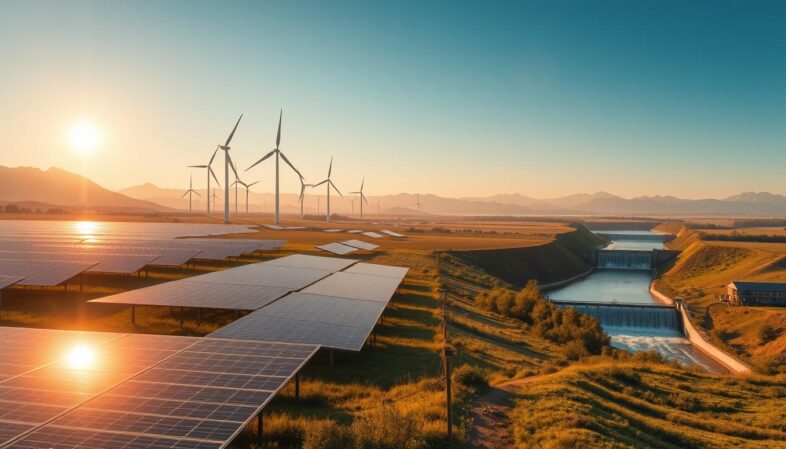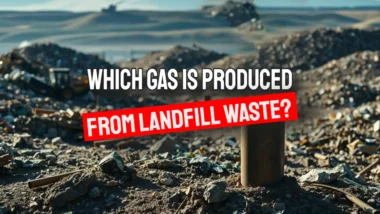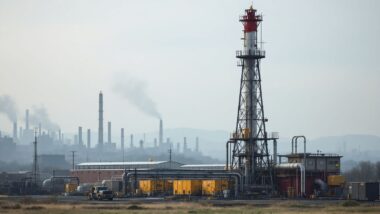The world is moving towards sustainable energy. Natural gas is seen as a cleaner choice than other fossil fuels. But, methane leaks during transport are a big worry about its greenness.
As energy needs keep rising, knowing about natural gas sustainability is key. This article will look into natural gas and if it's a good green energy choice.
Key Takeaways
- The role of natural gas in the energy transition
- Environmental impacts of natural gas, including methane leakage
- The possible role of biogas in sustainable energy
- Challenges in moving natural gas in a green way
- Natural gas as a step towards a greener energy future

Understanding Natural Gas: Composition and Current Usage
Natural gas is mostly methane. It's a fossil fuel made over millions of years. It's key in the world's energy mix.
It's used for heating, making electricity, and powering vehicles.
What Is Natural Gas and How Is It Formed?
Natural gas is a hydrocarbon mix, mostly methane. It has some other gases too. It comes from ancient sea life and plants buried for ages.
Global Natural Gas Consumption Patterns
Natural gas use changes a lot around the world. It depends on energy needs, economy, and green policies.
United States Natural Gas Market Overview
The U.S. is a big user and maker of natural gas. The U.S. market is driven by power plants and factories. People also use it for home heating.
Industrial vs. Residential Usage Statistics
The industrial sector uses the most natural gas in the U.S. It's for making things and chemicals. Homes also use a lot for warmth.
| Sector | Natural Gas Consumption (billion cubic feet) |
|---|---|
| Industrial | 8,762 |
| Residential | 4,974 |
| Commercial | 3,087 |
| Electric Power | 7,358 |
The Environmental Footprint of Natural Gas
Natural gas is seen as cleaner than coal. But, it has its own environmental worries. It makes fewer greenhouse gases than coal when used.
Greenhouse Gas Emissions Compared to Other Fossil Fuels
Natural gas has a lower carbon footprint than other fossil fuels. It mainly burns methane, which is cleaner than coal or oil.
Carbon Dioxide Output per Energy Unit
Natural gas makes less CO2 than coal for the same energy. It emits about 50-60% of the CO2 coal does. This makes natural gas better for the climate in the short term.
Air Quality Improvements vs. Coal
Using natural gas instead of coal improves air quality. Natural gas plants make fewer harmful particles and gases. This is good for public health.
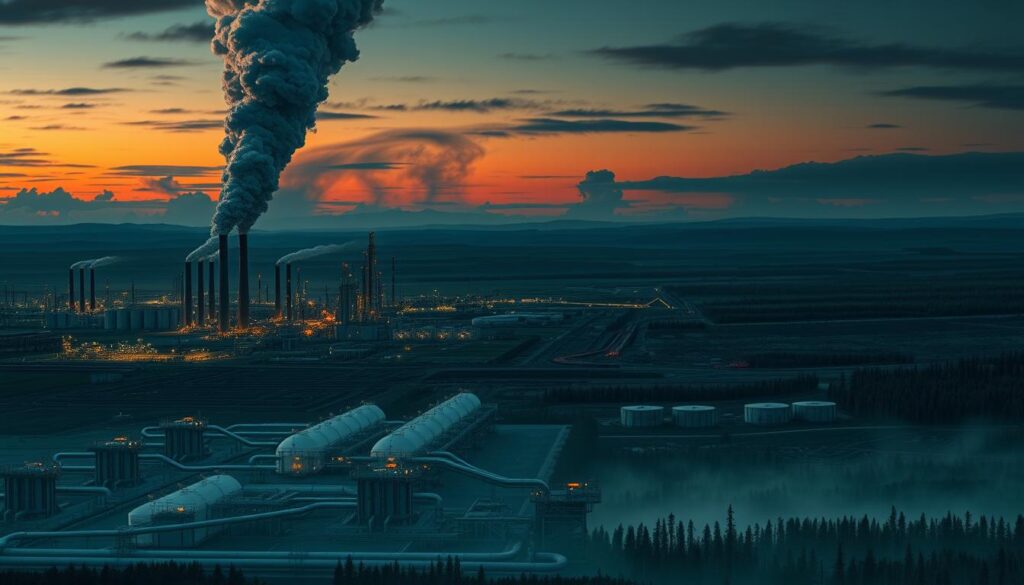
Methane Leakage: The Hidden Climate Impact
Natural gas has a big problem: methane leakage. Methane is a strong greenhouse gas. It's worse than CO2 over 20 years. Leaks happen at many stages, from production to delivery.
We need strict rules and new tech to find and stop leaks. Reducing methane emissions is key to making natural gas less harmful.
Is Natural Gas Sustainable? The Complete Analysis
Natural gas is seen as a ‘bridge fuel.' It has a complex story of sustainability. The world is facing climate change and energy security issues. Knowing natural gas's role in energy is key.
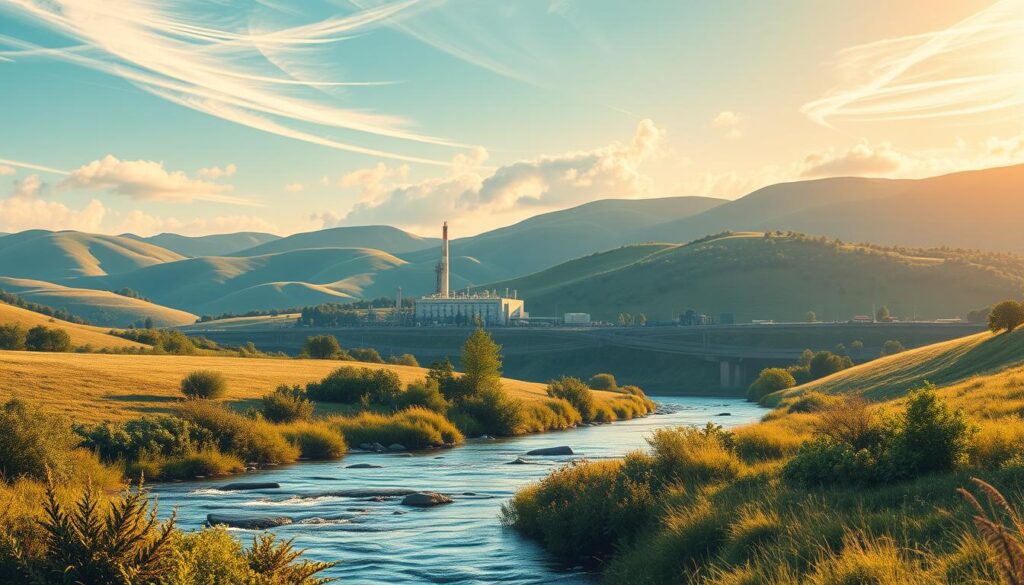
Defining Sustainability in Energy Resources
Sustainability in energy means we can use energy now without harming future generations. For natural gas, it's about its availability, environmental impact, economic value, and social acceptance.
Sustainability has three main parts: caring for the environment, being economically sound, and being socially responsible. Natural gas, being a fossil fuel, has big environmental challenges. These include greenhouse gas emissions and methane leakage.
“The transition to a low-carbon economy will require a significant reduction in greenhouse gas emissions, and natural gas can play a role in this transition.”
Short-term vs. Long-term Sustainability Considerations
In the short term, natural gas is cleaner than coal for electricity. But, long-term sustainability means we need to move to renewable energy to fight climate change.
Natural gas helps reduce carbon emissions in the short term. But, its long-term future is uncertain. It adds to greenhouse gas emissions and is a limited resource.
The Role of Natural Gas in Energy Transition
Natural gas is a ‘bridge fuel' for moving from coal and oil to renewables. It's a lower-carbon option for power and heating. But, we must cut methane leaks in the supply chain.
Energy transition plans with natural gas must be smart. They should help, not block, the goal of a low-carbon energy system.
Natural Gas vs. Renewable Energy Sources
Nowadays, we're all trying to cut down on carbon emissions. So, it's key to compare natural gas with renewable energy.
Comparing Carbon Footprints
Natural gas is seen as a cleaner choice than coal and oil. It has less carbon dioxide emissions. But, it's not as clean as solar and wind energy.
- Natural gas emits about 0.43 kg CO2/kWh.
- Solar energy emits about 0.05 kg CO2/kWh.
- Wind energy emits even less, around 0.01 kg CO2/kWh.
Renewable energy sources are getting better. This is because technology is improving and costs are going down.
Economic Viability and Market Competition
Deciding between natural gas and renewable energy is tricky. It depends on costs, government help, and what people want to buy.
Cost Analysis: Natural Gas vs. Solar and Wind
The price of renewable energy has dropped a lot. This makes it closer to natural gas in cost.
Renewable energy faces a big challenge: storing energy. But, new battery tech and other solutions are helping.
“The future of energy storage looks bright, with various innovative solutions being developed to meet the growing demand for renewable energy.” – Energy Storage Association
The Extraction Process: Environmental and Social Impacts
Extracting natural gas affects the environment and local people. As natural gas demand grows, knowing how it's extracted is important.
Conventional Drilling Methods
Conventional drilling gets gas from underground using old methods. It's less harmful than some new ways but can harm water and animals. Good drilling and rules help lessen these problems.
Hydraulic Fracturing (Fracking) Concerns
Fracking is a hot topic because of its environmental risks. It uses high-pressure fluids to get gas from shale, worrying about water, earthquakes, and methane. Fracking needs careful rules and watching to lessen harm.
Community and Ecosystem Effects
Getting natural gas affects local people and nature. It brings more cars, noise, and stress on local areas. Drilling also harms habitats and animals. It's important to think about people and nature when drilling.
In summary, getting natural gas has big effects on the environment and people. Knowing these impacts helps make the natural gas industry better.
Natural Gas Transportation and Infrastructure
Natural gas travels from where it's made to where it's used. This journey needs special roads for gas. These roads help gas get to where it's needed safely and well.
Pipeline Systems and Their Environmental Impact
Pipelines carry gas long distances. But, they can harm the environment. They might leak methane and hurt habitats.
Safety Considerations and Recent Developments
Keeping pipelines safe is very important. New tech makes them safer. This includes better ways to watch them and stronger materials.
- Advanced leak detection systems
- Enhanced pipeline coating to prevent corrosion
- Regular maintenance and inspection schedules
Land Use and Right-of-Way Issues
Building pipelines takes a lot of land. This causes problems with local areas and people.
Key considerations include talking to landowners, reducing harm to nature, and following rules.
LNG (Liquefied Natural Gas) Shipping Considerations
LNG shipping is key for moving gas around the world. But, it's complex and needs careful safety checks.
Economic viability matters too. LNG shipping costs a lot. It needs special plants and ships.
Getting natural gas to where it's needed is hard. It involves pipelines and LNG ships. We must think about the environment and safety when planning energy use.
Biogas and Renewable Natural Gas: Sustainable Alternatives
Biogas and renewable natural gas help us use less fossil fuel. They also help fight climate change. These options are becoming more popular as we look for ways to be more sustainable.
The Science Behind Biogas Production
Biogas comes from breaking down organic stuff without air. This makes a mix of methane and carbon dioxide.
It's all about tiny bugs and chemical reactions. Knowing this helps make more and better biogas.
Anaerobic Digestion Technology
Anaerobic digestion is key for making biogas. It uses special bugs to break down stuff without air.
Feedstock Options and Efficiency
What you use to make biogas matters. Stuff like farm waste, food scraps, and sewage sludge works well.
Biogas Upgrading to Biomethane
Biogas can become biomethane. This means it's as good as natural gas. It's cleaned up and has more methane.
Carbon-Neutral Potentia of Renewable Natural Gas
Renewable natural gas (RNG) can be carbon-neutral. It's made from biogas that's been cleaned up to natural gas standards.
A study by the Environmental Protection Agency (EPA) shows RNG's benefits. It says RNG cuts down on greenhouse gas emissions. The EPA notes, “RNG can reduce methane emissions from organic waste and provide a low-carbon energy source.”
“The use of RNG can significantly reduce the carbon footprint of natural gas consumption.”
The table below shows the main differences between regular natural gas and RNG.
| Characteristics | Traditional Natural Gas | Renewable Natural Gas |
|---|---|---|
| Source | Fossil Fuel | Organic Waste |
| Carbon Footprint | High | Low to Carbon-Neutral |
| Production Process | Drilling and Extraction | Anaerobic Digestion and Upgrading |
Policy Landscape and Future Regulations
The natural gas industry faces a complex policy world. It must meet energy needs and protect the environment. Rules for natural gas come from both the U.S. government and states.
Current U.S. Policies on Natural Gas
In the U.S., natural gas policies mix help and rules. Federal laws shape the industry a lot.
Federal Incentives and Restrictions
The government offers tax credits to boost natural gas production. But, it also has rules to lessen harm to the environment. These include limits on methane emissions.
State-Level Variations in Regulation
States have different rules for natural gas. Some support it, while others are stricter. For example, Pennsylvania allows fracking, but California has tougher rules.
International Agreements and Their Impact
Global deals, like the Paris Agreement, affect natural gas worldwide. They aim to cut down on greenhouse gases. This changes how countries use natural gas.
“The shift towards cleaner energy sources is not just a national issue but a global one.” Countries are looking at natural gas differently as they aim to cut emissions.
Countries are trying to fit natural gas into their plans for cleaner energy. They want to keep energy flowing while protecting the planet.
Conclusion: The Future Role of Natural Gas in a Sustainable Energy Mix
The world is changing how we get energy. Natural gas is a big part of this change. But, its future is not clear.
Natural gas has many uses and can be cleaner than coal or oil. Yet, it also has problems like greenhouse gas emissions and methane leaks. These are big environmental worries.
New options like biogas and renewable natural gas are good news. They help make natural gas cleaner. As we move forward, natural gas will likely be part of a mix of clean energy sources.
We need everyone to work together. This includes governments and companies. We must make sure natural gas fits into a green future.
FAQ
What is natural gas and how is it formed?
How does natural gas consumption impact the environment?
Is natural gas considered a sustainable energy source?
How does natural gas compare to renewable energy sources in terms of carbon footprint?
What is the role of natural gas in the energy transition?
What are the environmental impacts of hydraulic fracturing (fracking) for natural gas?
How is natural gas transported, and what are the associated environmental concerns?
What is biogas, and how does it differ from traditional natural gas?
How do current U.S. policies influence the natural gas industry?
What impact do international agreements have on natural gas policies and usage?
What is the future role of natural gas in a sustainable energy mix?
Methane Capture Systems: The Cure For Global Oil Addiction?
The world runs on oil, but this dependency creates serious problems. Air gets polluted, water sources get contaminated, and the climate crisis worsens. People are looking for better ways to reduce harm caused by our “oil addiction.” Methane capture systems might be a solution. These systems trap harmful gas released during oil and gas production. […]
Integration of Biogas Systems into the Energy System
Key Takeaways Biogas systems can significantly reduce reliance on fossil fuels by providing a renewable energy source. They play a crucial role in mitigating greenhouse gas emissions, helping combat climate change. Biogas systems offer scalable energy solutions tailored to local needs, particularly in rural areas. Integrating biogas into existing energy grids can enhance grid stability […]
How Much Does Net Zero Cost? The Estimates of Net Zero Expenses in 2024
Hey there! If you're wondering about the price tag of saving our planet, you're not alone. The question “how much does net zero cost?” has been keeping economists, politicians, and business leaders up at night. But here's some good news right off the bat: reaching net zero might be way cheaper than we originally thought! […]
Efficient Conversion of Sewage to Biogas: Advancing Waste Treatment for Sustainable Energy Generation
Read on to learn about advancing foul waste treatment, for sustainable energy generation through the efficient conversion of sewage solids to biogas. When we talk about waste, it can seem like a dirty subject. But what if we could turn that waste into something useful? Imagine the mucky water and sludge from our toilets and […]

